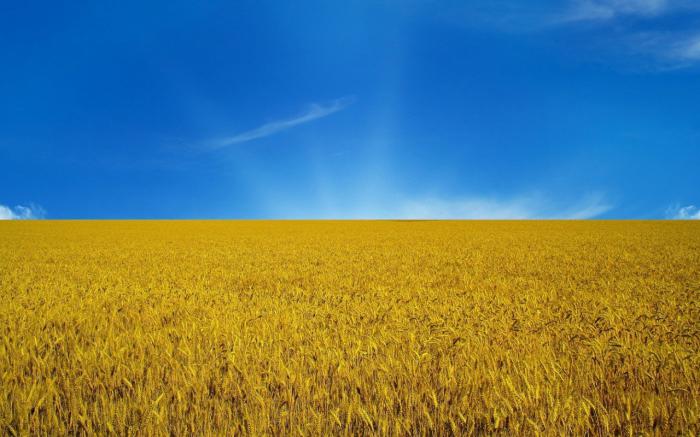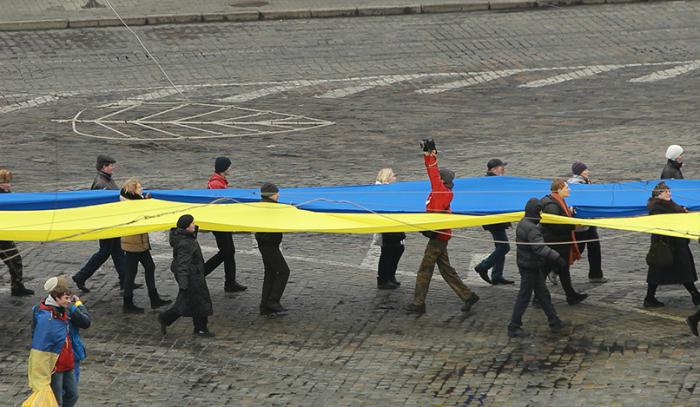No state exists without rituals and symbols. Ukraine has gained independence several times in its history. The last time this happened in 1991. Four months later, the small emblem and flag of Ukraine, a stylized trident and a two-color canvas consisting of horizontal fields, blue and yellow, were approved. According to historians who describe the events associated with the collapse of the USSR, the century-old dream of the majority of the population of that part of the Union that lived on the territory of the former USSR was fulfilled.

The historical contradictions between the East and West of this country have caused many dramatic events, conflicts have arisen and continue to glow, including armed ones. After the "Maidan" the opinion of the citizens of the Southeast government "independent" has ceased to be taken into account. In turn, residents of some regions refuse to positively perceive the attributes of the state, including the flag of Ukraine. Photos from the scene of the tragic events that caused the victims in Odessa, Mariupol, Zaporozhye and other cities give an explanation for such rebellion. For a large percentage of the population, yellow-blue paints have become a symbol of violence and cruelty. This is not forgotten.
Yellow-blue origins
The history of the flag of Ukraine rests on its origins in those days when geographical names were completely different. In pre-Christian Russia, yellow and its shades symbolized the fiery element. Blue represented water, an endless source of life. In this gamut, the traditionally pagan holiday of Ivan Kupala was held: with a fiery wheel rolling in the water, with lights floating on rivers and streams and other ancient attributes.
While the Slavs did not have any flags, the role of military symbols was played by banners, which were bundles of various bright and visible from afar objects, from bird feathers to grassy colors. Starting from the fourteenth century, there was a delimitation of spheres of influence between the European West (represented by the Polish-Lithuanian Commonwealth, the Grand Duchy of Lithuania) and the Russian lands. Part of Kievan Rus' became the frontier edge (it was still too early to talk about state borders then), hence the future name of the country.
As part of the Commonwealth
For the first time the flag of Ukraine became known during the battle of Grunwald (1410), however, at that time it did not personify an independent power. Units of the Polish army, recruited from the inhabitants of Leopolska (Lviv) land, opposed the crusaders under a banner showing a yellow lion on a bluish-azure field.
Ethnic symbolism was further developed during the war for liberation from Polish oppression under the leadership of Bohdan Khmelnitsky (1648-1654). However, the colors were different then, preference was given to raspberry and red shades, such contemporaries described the Hetman Cossack banners.
National symbolism in one form or another was preserved as applied to military attributes and emblems of Little Russian cities throughout the entire existence of the Russian Empire and after the February Revolution. So, the case is known when General Brusilov welcomed in May 1917 units of Ukrainian volunteers who arrived on the German front under the national flag.
Austrian Ukrainophiles and the flag presented
An interesting case occurred after the suppression of the Austrian revolution of 1848 by the Russian army. The pro-Russian sympathies of the local population were so frightened by the rescued Habsburg government that it resigned in full force, and the Governor Stadium took a rather non-standard political step. He expressed his readiness to support the Ukrainians striving for autonomy if they did not consider themselves Russian by handing them the yellow-blue flag of Ukraine, allegedly sewn by the mother of the Austrian emperor (which was not true).
Revolution
The events of the 1917 revolutions led to a redrawing of borders and a reassessment of historical perspectives. After the proclamation in 1918 of the UNR (Ukrainian People’s Republic), a provisional law was passed, according to which the state flag of Ukraine was officially established for the first time, with the yellow color on top. Then there was a coup, as a result of which the hetman Skoropadsky seized power, starting with the fact that he changed places. The national symbol of this banner remained among the supporters of independence, operating underground in the territories occupied by Poland, Romania and Czechoslovakia until 1939. With a yellow-blue ensign in 1939, Western Ukrainians met the Red Army.
Flag of the Ukrainian SSR
After the 1917 revolution , the Soviet part of Ukraine refused to recognize the power of the Central Rada. In Kharkov, its flag was adopted, of course, red, with the letters U.S. S. R. Then, in 1937, an amendment was made, the advice in Ukrainian is “glad”, therefore, you need to write U. R. S. S. R. however, in places of residence of the Russian-speaking population it was allowed in Russian.
Decades later, the Soviet flag of Ukraine was again changed. The lower third was occupied by a blue cloth, and the rest, crowned with a sickle and a hammer, remained red.
During the tragic period of the Nazi occupation, collaborators used national yellow and blue colors, however, until the German command banned. Bandera underground used, in addition to Petliura, another flag, black and red.
Modern flag of Ukraine
Photos and filming, which shows the ceremonial introduction into the conference room of the Supreme Council of the Ukrainian SSR of a giant yellow-blue banner, went around all the information channels of the world in 1991. This action was welcomed by a prominent party communist functionary L.M. Kravchuk, who became the first president of independent Ukraine. This event was accompanied by mass events painted in the same tones. Thus began the newest history of the flag of Ukraine. Patriotic citizens tied yellow-blue ribbons, protesting against the "capture" of the Crimea. Other ribbons, symbols of the Victory over Nazism, St. George’s, are prohibited. According to the current leadership, they are worn by "separatists", "quilted jackets" and "Colorado."

The colors of the flag of Ukraine, by design, should symbolize peacefulness and food abundance. The blue sky crowns the fields of golden wheat, generously growing on the famous Ukrainian black soil - this is how the range of the main state symbol of the country is interpreted. How much this dream will come true, time will tell ...